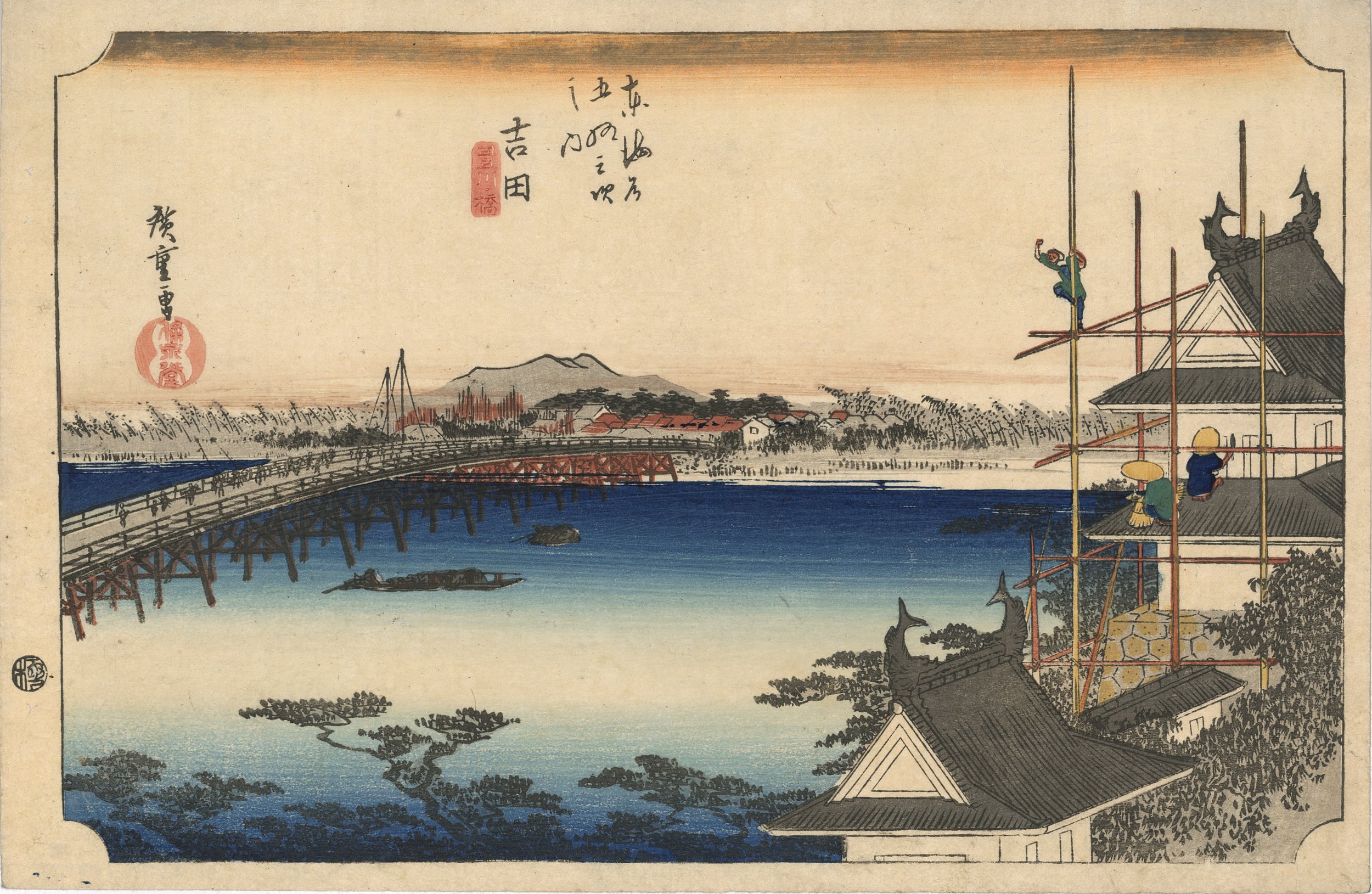Hiroshige | Yoshida, from the 53 Stations of the Tokaido
歌川広重 Utagawa Hiroshige (1797-1858)
东海道五十三次之内 吉田 丰川桥
Yoshida, from The Fifty-three Stations of the Tokaido
1833-34
木版画 | 横绘大判 | 25cm x 38cm
Woodblock-print | Oban yoko -e | 25cm x 38cm
早期版次;颜色保存非常好;有轻微污渍;右边边缘有四个非常小的先前册页小洞
Early impression; fine color; very minor soiling; 4 tiny holes from previous album binding in the left margin
《东海道五十三次之内》是歌川广重于1833年至1834年推出的横版名所绘系列,全套共计55张。作为广重最负盛名的代表作之一。此系列一经推出,便成为名所绘的里程碑,并且掀起了后世浮世绘画师以东海道为主题的创作热潮,无论从艺术价值和历史意义而言,都堪称最杰出的浮世绘系列之一。
吉田,即吉田宿,位于今日本爱知县丰桥市,是东海道五十三次中的第三十四处宿场,其域内的丰川桥又名吉田大桥,颇具气势,好似一条200米的长龙横跨了丰川两岸。但若只是描绘它,未免又有些单调,匠心独具的广重选取了稍呈俯视的视角,将近景中正在修缮的吉田城天守阁移入画中:灰瓦白墙,鯱跃屋脊,虽只露出半角,但仍可一窥天守阁的雄伟壮丽。脚手架间,两位头戴草帽的泥瓦匠正粉刷修补着阁体,而在他们左上方,一位可爱的鸢职人(高空作业修建工)正手搭“凉棚”、单脚站定,在脚手架上向丰川桥方向眺望,配合上手握架管的动作,活脱脱一个孙猴儿形象。这俏皮的小模样,也与疏朗开阔的远景形成了鲜明对比,使画面达到了精致感与趣味性的高度统一,实为难得佳作。
Interested in purchasing?
Please contact us.
歌川広重 Utagawa Hiroshige (1797-1858)
东海道五十三次之内 吉田 丰川桥
Yoshida, from The Fifty-three Stations of the Tokaido
1833-34
木版画 | 横绘大判 | 25cm x 38cm
Woodblock-print | Oban yoko -e | 25cm x 38cm
早期版次;颜色保存非常好;有轻微污渍;右边边缘有四个非常小的先前册页小洞
Early impression; fine color; very minor soiling; 4 tiny holes from previous album binding in the left margin
《东海道五十三次之内》是歌川广重于1833年至1834年推出的横版名所绘系列,全套共计55张。作为广重最负盛名的代表作之一。此系列一经推出,便成为名所绘的里程碑,并且掀起了后世浮世绘画师以东海道为主题的创作热潮,无论从艺术价值和历史意义而言,都堪称最杰出的浮世绘系列之一。
吉田,即吉田宿,位于今日本爱知县丰桥市,是东海道五十三次中的第三十四处宿场,其域内的丰川桥又名吉田大桥,颇具气势,好似一条200米的长龙横跨了丰川两岸。但若只是描绘它,未免又有些单调,匠心独具的广重选取了稍呈俯视的视角,将近景中正在修缮的吉田城天守阁移入画中:灰瓦白墙,鯱跃屋脊,虽只露出半角,但仍可一窥天守阁的雄伟壮丽。脚手架间,两位头戴草帽的泥瓦匠正粉刷修补着阁体,而在他们左上方,一位可爱的鸢职人(高空作业修建工)正手搭“凉棚”、单脚站定,在脚手架上向丰川桥方向眺望,配合上手握架管的动作,活脱脱一个孙猴儿形象。这俏皮的小模样,也与疏朗开阔的远景形成了鲜明对比,使画面达到了精致感与趣味性的高度统一,实为难得佳作。
Interested in purchasing?
Please contact us.
歌川広重 Utagawa Hiroshige (1797-1858)
东海道五十三次之内 吉田 丰川桥
Yoshida, from The Fifty-three Stations of the Tokaido
1833-34
木版画 | 横绘大判 | 25cm x 38cm
Woodblock-print | Oban yoko -e | 25cm x 38cm
早期版次;颜色保存非常好;有轻微污渍;右边边缘有四个非常小的先前册页小洞
Early impression; fine color; very minor soiling; 4 tiny holes from previous album binding in the left margin
《东海道五十三次之内》是歌川广重于1833年至1834年推出的横版名所绘系列,全套共计55张。作为广重最负盛名的代表作之一。此系列一经推出,便成为名所绘的里程碑,并且掀起了后世浮世绘画师以东海道为主题的创作热潮,无论从艺术价值和历史意义而言,都堪称最杰出的浮世绘系列之一。
吉田,即吉田宿,位于今日本爱知县丰桥市,是东海道五十三次中的第三十四处宿场,其域内的丰川桥又名吉田大桥,颇具气势,好似一条200米的长龙横跨了丰川两岸。但若只是描绘它,未免又有些单调,匠心独具的广重选取了稍呈俯视的视角,将近景中正在修缮的吉田城天守阁移入画中:灰瓦白墙,鯱跃屋脊,虽只露出半角,但仍可一窥天守阁的雄伟壮丽。脚手架间,两位头戴草帽的泥瓦匠正粉刷修补着阁体,而在他们左上方,一位可爱的鸢职人(高空作业修建工)正手搭“凉棚”、单脚站定,在脚手架上向丰川桥方向眺望,配合上手握架管的动作,活脱脱一个孙猴儿形象。这俏皮的小模样,也与疏朗开阔的远景形成了鲜明对比,使画面达到了精致感与趣味性的高度统一,实为难得佳作。
Interested in purchasing?
Please contact us.
Utagawa Hiroshige (1797-1858)
Ando Hiroshige (1897-1858) revolutionized the art of landscape prints during the Edo era, building on the success of his senior, Hokusai, but taking a more poetic and naturalist approach to portraying the beauty of Japan.
The son of a low-level Samurai assigned to the fire brigade in Edo, Hiroshige became a student of the Utagawa school as a young man. His first prints focused on beautiful women (bijin), and views of Edo. But in 1833 he began work on his most famous early work, his first series depicting the Tokaido, the "Great Sea Road" between Edo and Tokyo.
Today there is some controversy about this series. Initially, it was believed that Hiroshige had travelled the route along with a local lord (Daimyo) who was making a gift of horses to the Emperor. But more recent scholarship suggests Hiroshige never travelled the road himself, at least not the entire way, and made his designs using published guidebooks.
Nonetheless, the prints were wonderful and revolutionary. They embraced the seasons with a gentle lyricism missing from Hokusai's striking but stylized depictions. In Hiroshige's work, nature is sacred -- but it is always mixed with humanity, with travelers or little inns or bridges. There is a magical harmony between man and the elements.
His depiction of the seasons and weather is especially evocative. Snow blankets some views with a hushed silence, while rain streaks down furiously in others. In some prints natured is agitated; in others, calm prevails. Produced in a horizontal oban yoko-e format, the series was a smash hit.
The Tokaido series made Hiroshige famous, and he became incredible prolific. In the 1840s he produced many strong designs, but many mediocre ones, too, including several subsequent Tokaido series of varying quality.
In 1853, however, he made a big step. He turned his landscapes sideways, embracing a bold vertical oban tate-e format. This gave his designs new energy and a modern feel. The first of these was Famous Views of the Sixty-Odd Provinces. From them on, most of his most noted series were executed in this format.
He saved his greatest for his last. In 1856 he began work on 100 Famous Views of Edo, which many consider his most exceptional work. Here his home city was portrayed with energy and passion, and in these 119 designs he created an incredible record of a vanished place. In addition to the striking vertical format, he developed exciting new compositions, often juxtaposing a strong foreground element with a distant background.
Among the many famous images in this series are Squall at Ohashi and the Plum Garden in Komeido. Both of these were copied by Vincent Van Gogh, a great admirer of Hiroshige. Thus, the great Japanese artist had a profound effect on Western art.
Alas, his beloved Edo ended his life. Hiroshige was claimed by a cholera epidemic that swept the city in 1958. His pupil Shigenobu, who took the name Hiroshige II, completed The Famous Views of Edo.


